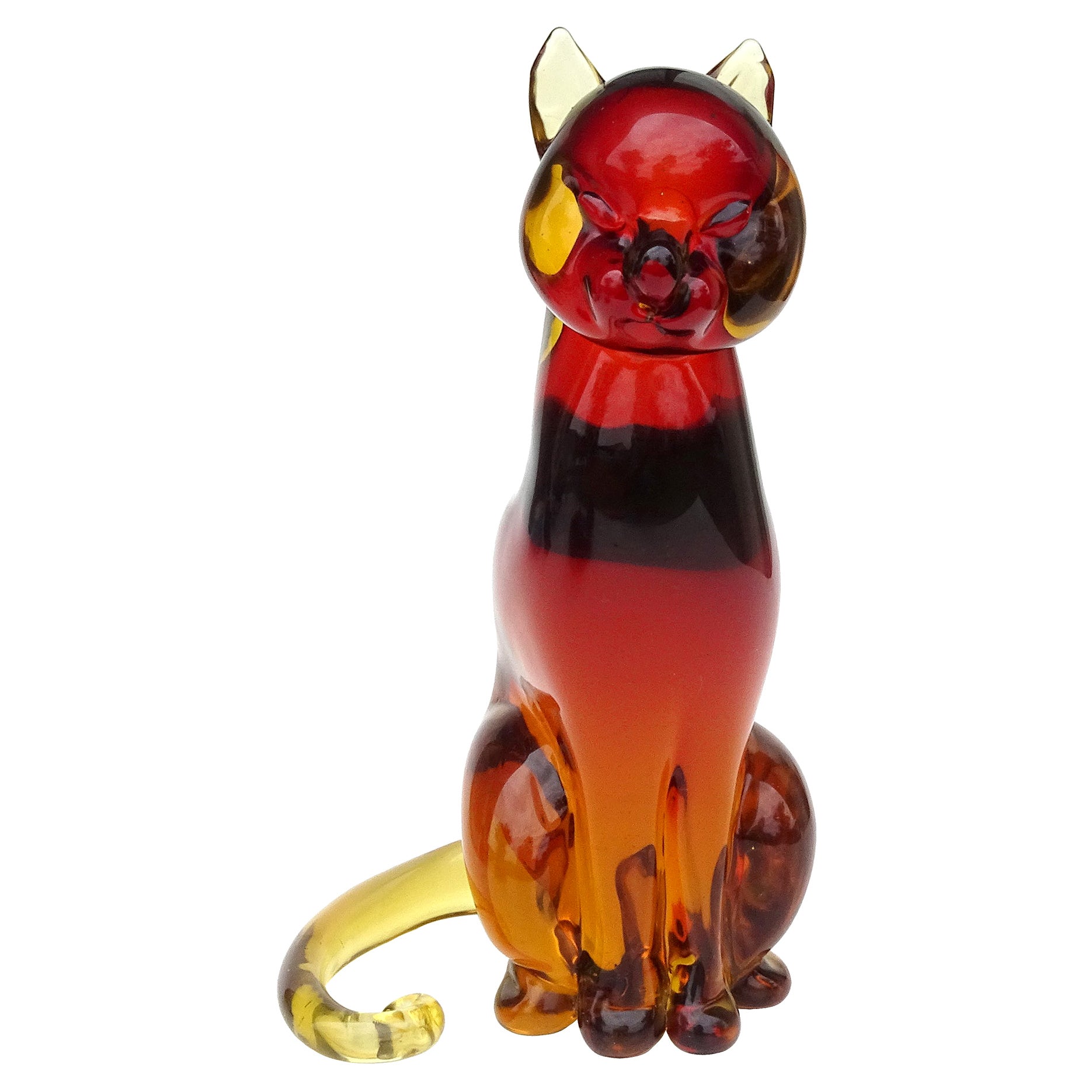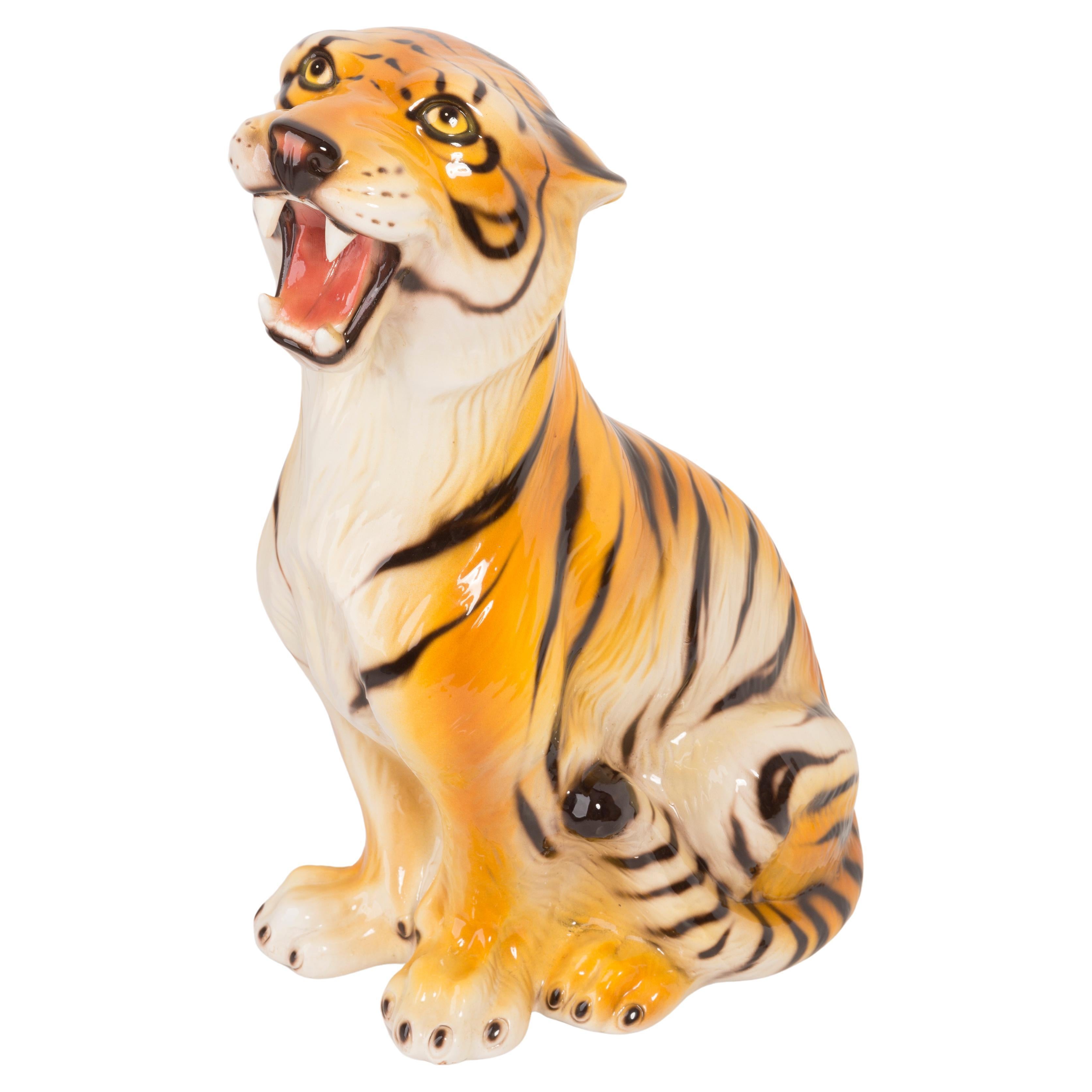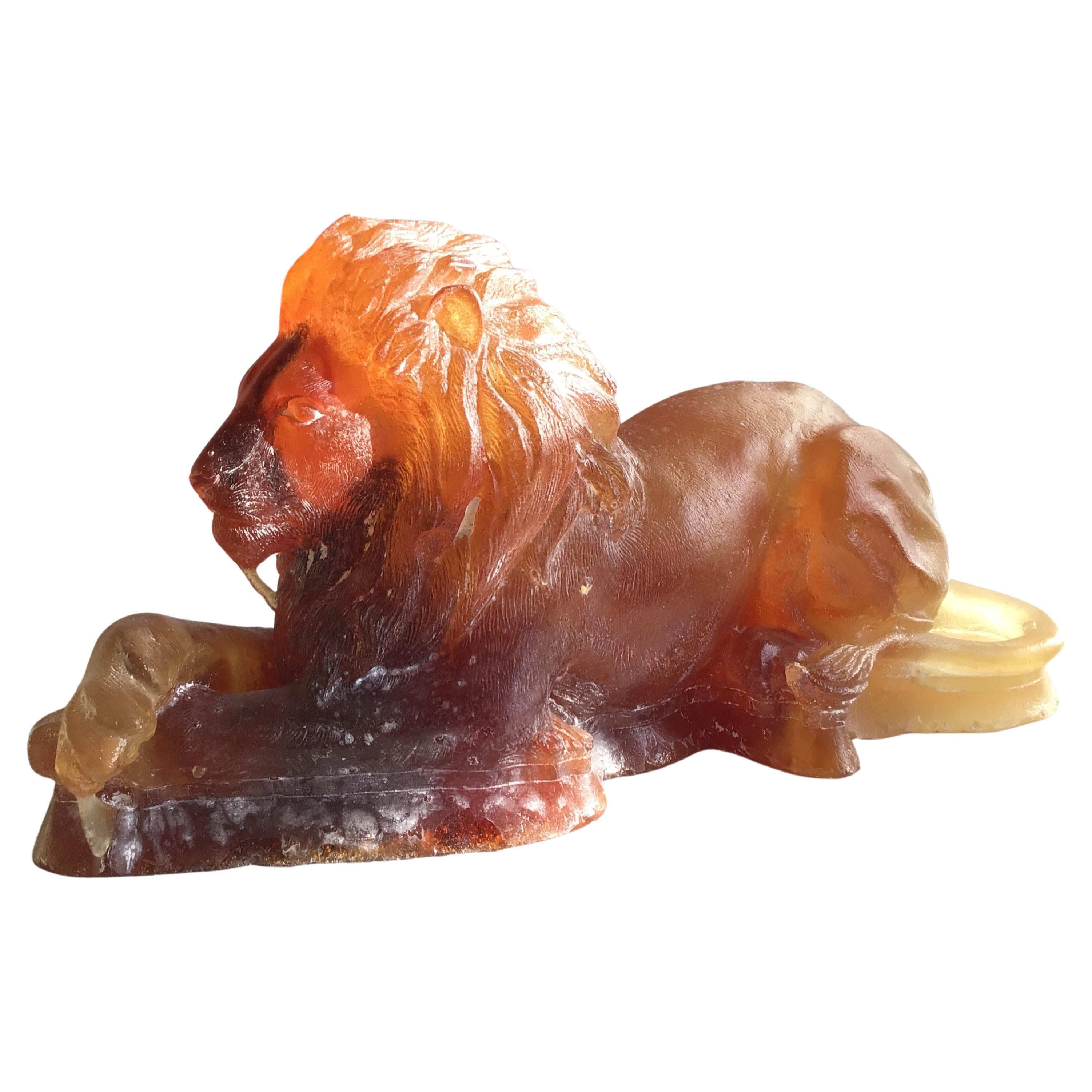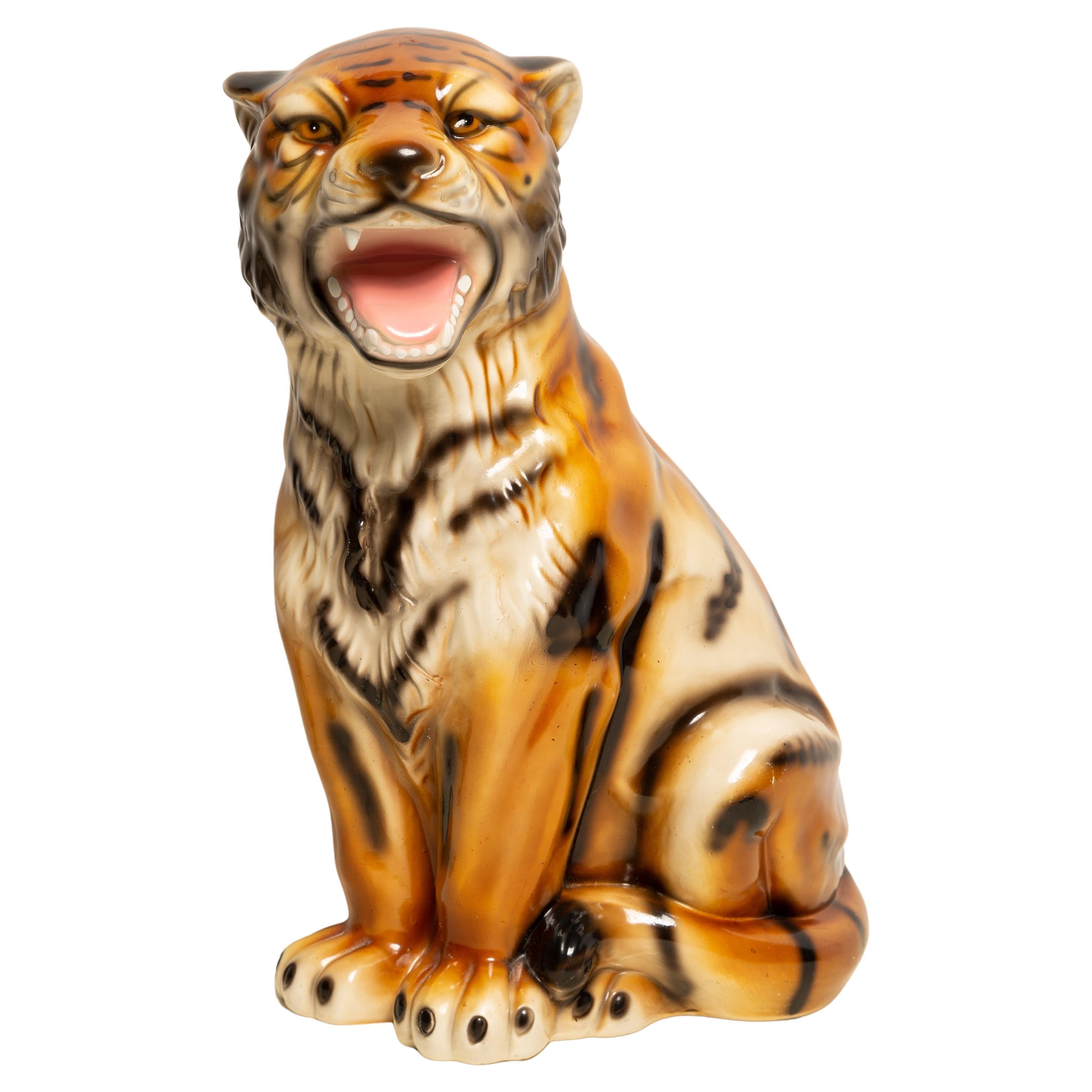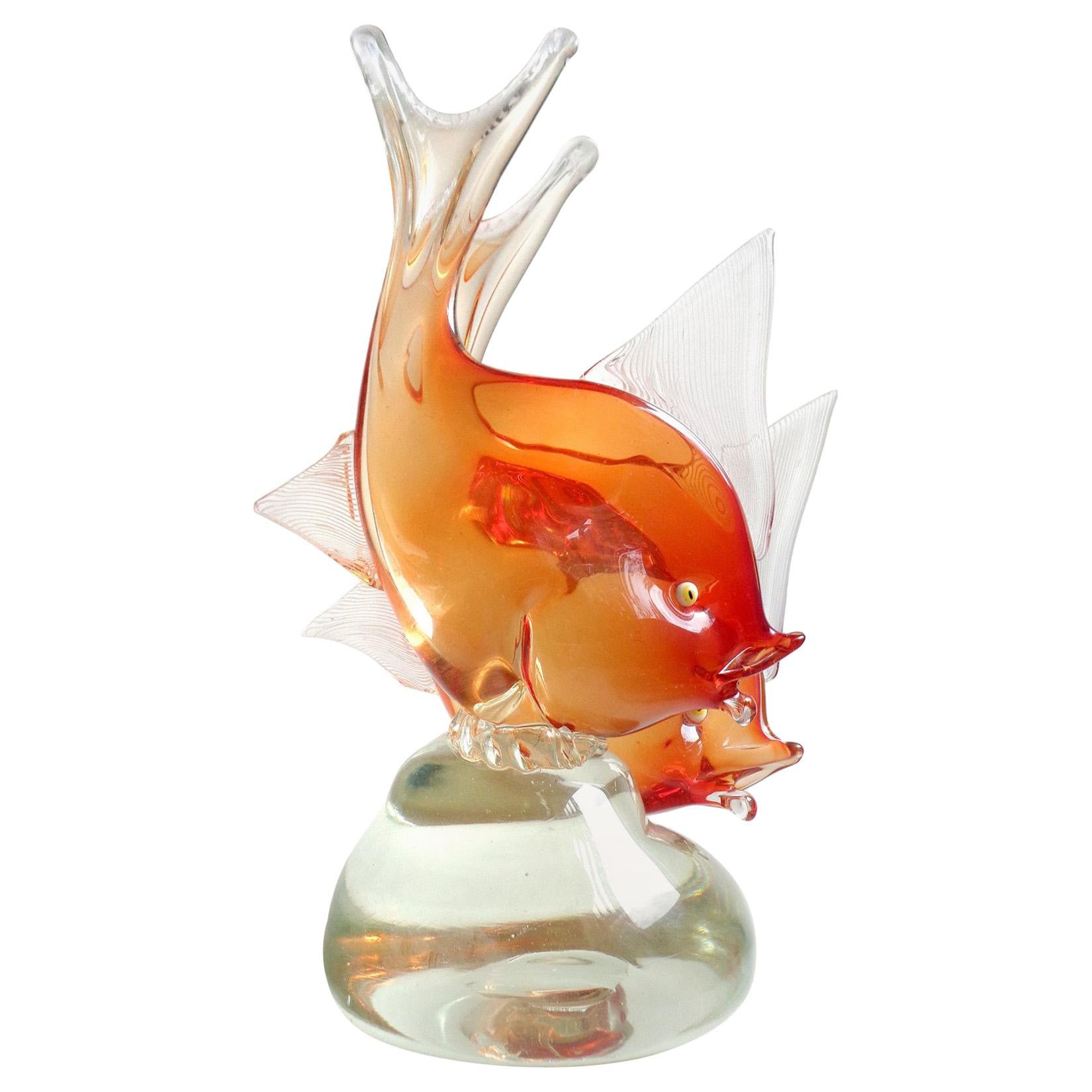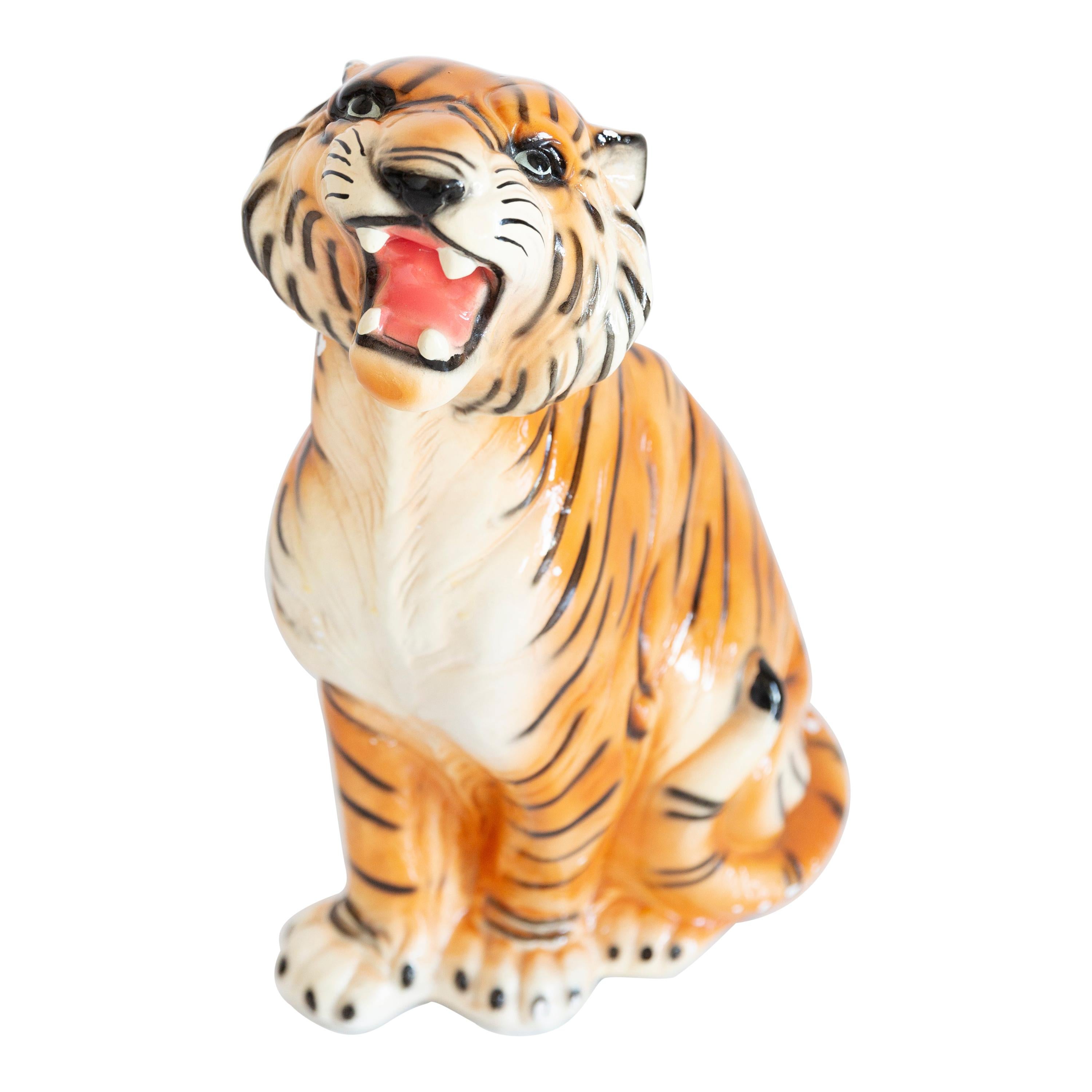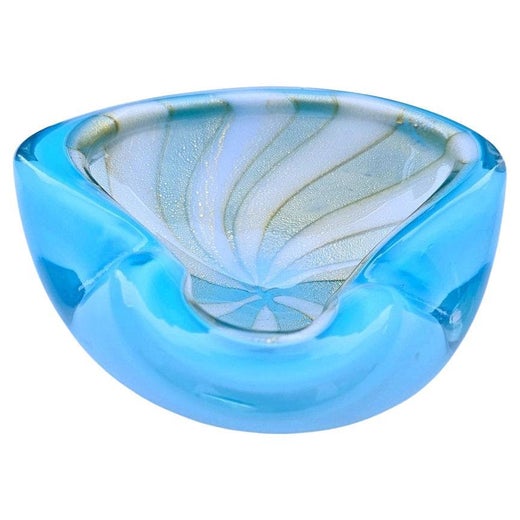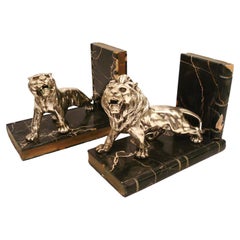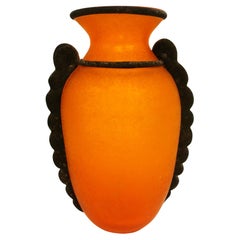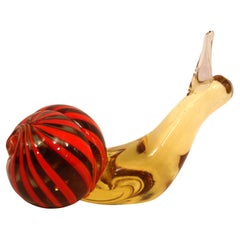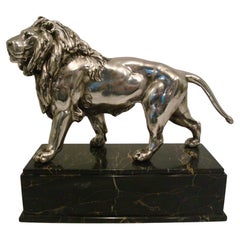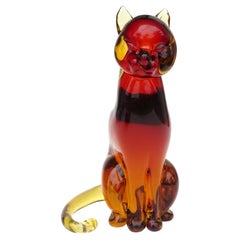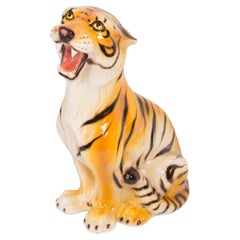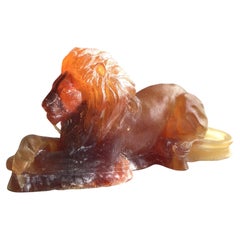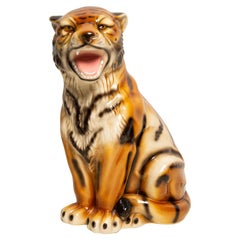Items Similar to Murano Orange and Gold Flecks Italian Art Glass Roaring Tiger Figure Sculpture
Want more images or videos?
Request additional images or videos from the seller
1 of 14
Murano Orange and Gold Flecks Italian Art Glass Roaring Tiger Figure Sculpture
$1,800
£1,365.80
€1,561.67
CA$2,514.11
A$2,795.35
CHF 1,459.58
MX$34,026.22
NOK 18,623.58
SEK 17,449.40
DKK 11,655.02
Shipping
Retrieving quote...The 1stDibs Promise:
Authenticity Guarantee,
Money-Back Guarantee,
24-Hour Cancellation
About the Item
Rare Vintage Large Italian Murano Art Glass Roaring Tiger Sculpture.
By Alfredo Barbini, 1950´s.
Large Murano hand blown orange and gold flecks art glass tiger sculpture. The figure is well detailed, with ears back, roaring with a force that shows through all its muscles, taking menacing steps forward. The stripes are red color and cover the entire piece.
Fantastic mid century sculpture.
Similar sculpture was Exhibited on the Camere D’Artista Italian design, 1930-1960 Villa Bertelli Forte dei Marmi.
We have specialized in the sale of Art Deco and Art Nouveau and Vintage styles since 1995. If you have any questions we are at your disposal. Pushing the button that reads 'View All From Seller'. And you can see more objects to the style for sale. Why are there so many antiques in Argentina?
In the 1880 – 1940 there was a grate wave of immigration encouraged by the periods of war that were taking place. 1st World War took place between 1914 and 1918 2nd World War took place between 1939 and 1945 The immigrants options were New York or Buenos Aires. Tickets were cheap and in Buenos Aires they were welcomed with open arms, as it was a country where everything was still to be done. Argentina was the country of new opportunities, labour was needed and religious freedom was assured, in many cases the of the family travel first until they were settled and then the rest of the family members join them. In the immigrant museum “Ellis Island Immigrant Building” in New York you can se the promotional posters of the boats that would take them to a new life. Between the years 1895 and 1896, Argentina had the highest DGP (gross domestic product) per capita in the world according to the Maddison Historical Statistics index, this situation arose due to the large amount of food being exported to European countries, which were at war. The Argentinean ships left the port of Buenos Aires with food, but they returned with furniture, clothes and construction elements, (it´s common to see this the old buildings of the historic neighbourhood of San Telmo, the beams with the inscription “Made in England)”, as well as many markets that were built in Buenos Aires, such us the San Telmo Market, whose structure was brought by ship and afterwards assembled in 900 Defensa Street. With the great influence of European immigrants living in the country, the children of the upper classes travelled to study in France, resulting in the inauguration of “La Maison Argentinienne”, on 27th of June 1928, in the international city of Paris, which hosted many Argentinians that were studying in Frace. It´s the fourth house to be built after France, Canada and Belgium, being the first Spanish-speaking one. Still in place today (17 Bd Jourdan, 75014, Paris, France). Many of the children of these wealthy families who attended international art exhibitions, museums and art courses abroad, took a keen interest in the European style. This is why Buenos Aires was at the time referred as “The Paris of South America”. Between the years 1890 and 1920 more than a hundred Palaces were built on Alvear Avenue the most exclusive avenue in Buenos Aires. Today some of these palaces have been transformed into museums, hotels and embassies. In the year 1936, the Kavanagh building was inaugurated, it was the tallest reinforced concrete building in South America. During 1994 the American Society of Civil Engineers distinguished it as an “international engineering milestone”, and it´s now considered a World Heritage of Modern Architecture. At the time was common to hire foreign architects such as Le Corbusier, who visited Buenos Aires/Argentina in 1929 and in 1948 he drew up the blueprints for a house built in La Plata City (which was declared a World Heritage Site). In 1947, the Hungarian architect Marcelo Breuer designed “Parador Ariston” in the seaside city of Mar del Plata. After an Argentinean student at Harvard University convinced him to come to Argentina. He worked on an urban development project in the Casa Amarilla, area of La Boca. The Ukrainian architect, Vladimiro Acosta, arrives in Argentina in 1928 and worked as an architect until que moved to Brazil. Antonio Bonet, a Spanish architect who worked with Le Corbusier in Paris, arrives in Argentina in 1937, where he carried out several architectural works and in 1938 designs the well-known BFK chair. Andres Kálnay, of Hungarian origin, made around 120 architectural masterpieces, among which the former Munich brewery stands out, he even made the furniture’s design. The German architect, Walter Gropius, director of the Bauhaus, lived in Argentina, where he wrote articles for “Sur” magazine and founded in Buenos Aires, an architectural firm with Franz Möller, who was also an architect, where he built two houses. At the same time several famous designers decided to immigrate to Argentina, among them we can find the well-known French designer, Jean-Michel Frank, who arrived in the country in 1940 and also worked for the Rockefeller family. Special pieces were made, which were sold exclusively in the country, such as the well-known German company “WMF”, who sold their products by catalogue, which were chosen by the ladies of high society in the list of wedding gifts, as well as the pieces designed by Christofle. The Swiss sculptor Alberto Giacometti, made special pieces for Argentinean mansions. In 1904 the first Jansen branch outside Paris was established in Buenos Aires, as the Argentinean clientele demanded a large amount of furniture, from the end of the 19th century to the mid-20th century. In 1970, the brand Rigolleau Argentina made pieces authorised by Lalique. The brands Maple and Thompson also set up shop in the country. The French plastic artist, Marcel Duchamp moved to Argentina in 1918-1919. Glass signed Gallé, Charder, Leverre, Schneider, Muller and other French firms. They were bought in flower shops and were given to ladies with beautiful floral arrangements. Some furniture manufacturers travelled to international fairs and bough the patterns to produce the furniture in Argentina, such as the furniture firm Englander and Bonta, who bought the patterns in Italy. It is worth mentioning that in Argentina we have the largest community of Italians outside of Italy, as it is estimated that 70 percent of the inhabitants have at least one Italian descendant, followed by Spanish immigrants. The most Important furniture stores in Argentina: Comte is founded in 1934 (under the direct management of Jean Michel Frank in 1940). Nordiska (Swedish company established in 1934). Churba in 1960, a company that brought foreign designers to present their furniture in the country: Denmark: (Arne Jacobsen, Finn Juhl, Bender Madsen, Ejner Larsen, Poul Kjaerholm, Hans Wegner) Sweden: (Hans Agne Jakobsson, Gustavsberg) United States: (Herman Miller) Finland: (Lisa Johansson, Folke Arstrom, Tapio Wirkkala, Alvar Aalto, Timo Sarpaneva) Swedish Factory: (Orrefors) Italy: (Littala, Vico Magistretti, Emma Gismondi, Gae Aulenti, Angelo Mangiarotti, Elio Martinelli, Gianna Celada, Angelo Mangiarotti, Mario Bellini, Carlo Scarpa) Finland: (Olivia Toikka) Plata Lappas (Lappas Silver): a goldsmith shop founded in 1887 in Argentina by Alcibiades Lappas of Greek origin. In 2019, in Argentina took place “the Art Deco world congress” . Argentina currently has more than 100 Art Deco buildings and another 90 Art Nouveau buildings throughout the city of Buenos Aires. Argentina is a country that has not been involved in many wars, which is why it has been a refuge for works of art and antiques from different periods of time, unlike European countries. That is way many collectors, museums and antique dealers from all over the world visit it, you should not miss the opportunity to visit this great country.
- Creator:Alfredo Barbini (Artist)
- Dimensions:Height: 5.91 in (15 cm)Width: 12.6 in (32 cm)Depth: 5.91 in (15 cm)
- Style:Mid-Century Modern (In the Style Of)
- Materials and Techniques:
- Place of Origin:
- Period:
- Date of Manufacture:1950´s
- Condition:Wear consistent with age and use. Very Good Conditions.
- Seller Location:Buenos Aires, AR
- Reference Number:1stDibs: LU2027341772662
Alfredo Barbini
Alfredo Barbini (1912–2007), a glass artist born in 1912 on the islands of Murano in the lagoon of Venice, Italy, was one of Murano's leading figures of the 20th century. His parents were members of families, which had been prominent in the glassmaking industry on Murano for generations as glassblowers and beadmakers.
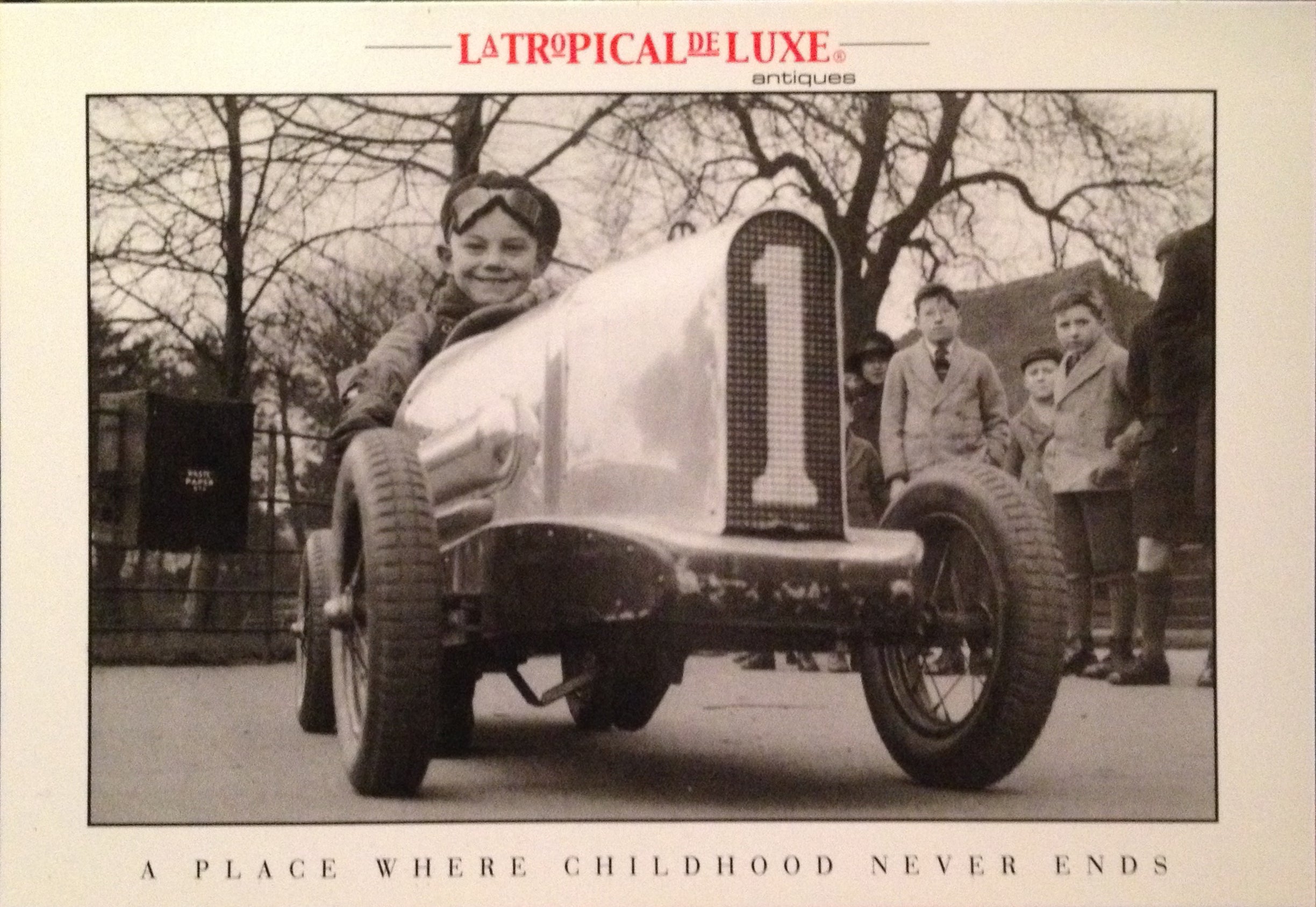
About the Seller
4.9
Vetted Professional Seller
Every seller passes strict standards for authenticity and reliability
Established in 2002
1stDibs seller since 2016
320 sales on 1stDibs
Typical response time: 1 hour
- ShippingRetrieving quote...Shipping from: Buenos Aires, Argentina
- Return Policy
Authenticity Guarantee
In the unlikely event there’s an issue with an item’s authenticity, contact us within 1 year for a full refund. DetailsMoney-Back Guarantee
If your item is not as described, is damaged in transit, or does not arrive, contact us within 7 days for a full refund. Details24-Hour Cancellation
You have a 24-hour grace period in which to reconsider your purchase, with no questions asked.Vetted Professional Sellers
Our world-class sellers must adhere to strict standards for service and quality, maintaining the integrity of our listings.Price-Match Guarantee
If you find that a seller listed the same item for a lower price elsewhere, we’ll match it.Trusted Global Delivery
Our best-in-class carrier network provides specialized shipping options worldwide, including custom delivery.More From This Seller
View AllPair of French Lion and Tiger Bookends
Located in Buenos Aires, Olivos
Pair of French Lion and Tiger Bookends
A pair of bookends. Each bookend features a metallic sculpture of a big cat, with one being a lion and the other a tiger. The sculptures are mo...
Category
Early 20th Century French Empire Animal Sculptures
Materials
Marble, Metal
$1,700 / set
Mid-Century Scavo Orange Hand-Blown Murano Glass Vase
By Cenedese, Archimede Seguso
Located in Buenos Aires, Olivos
This unique and stunningly made Mid-Century Modernist Scavo Orange Volcanic Hand-Blown Murano Glass Vase originates from Italy.
Orange vase with a matte finish. The vase has a round...
Category
Late 20th Century Italian Mid-Century Modern Vases
Materials
Murano Glass
Mid Century Hand Blown Two-Tone Murando Art Glass Snail - Italy 1960´s
By Livio Seguso
Located in Buenos Aires, Olivos
Mid Century Hand Blown Two-Tone Murando Art Glass Snail - Italy 1960´s.
This charming stylized snail by Livio Seguso, exemplifies the finesse of the Venetian Glass masters skills in ...
Category
Mid-20th Century Italian Mid-Century Modern Figurative Sculptures
Materials
Murano Glass
Large Silvered Lion Sculpture, France, Early 20th Century
Located in Buenos Aires, Olivos
An early 20th century Silverplated Lion. This particular example very well modelled. Mounted over a Portoro Italian marble base. Perfect size to...
Category
Early 20th Century French Neoclassical Animal Sculptures
Materials
Marble, Metal
$2,800 Sale Price
20% Off
Art Deco Silvered Bronze Lioness Figures Bookends by Roger Godchaux
By Godchaux
Located in Buenos Aires, Olivos
Roger Godchaux (1878 - 1958): two lioness figures / sculptures
Silvered bronze mounted as bookends on marble plinths; both with plaque to base inscribed "Godchaux Sclp./ Susse Fres...
Category
Vintage 1930s French Art Deco Animal Sculptures
Materials
Marble, Bronze
Art Deco Silvered Bronze Tiger Bookends - France 1930´s
Located in Buenos Aires, Olivos
Art Deco Silvered Bronze Tiger Bookends - France 1930´s
Tigers are mounted over Belgium Black Marble.
We have specialized in the sale of Art Deco and A...
Category
Mid-20th Century French Art Deco Bookends
Materials
Belgian Black Marble, Bronze
You May Also Like
Seguso Murano Sommerso Red Orange Italian Art Glass Regal Kitty Cat Sculpture
By Archimede Seguso
Located in Kissimmee, FL
Beautiful and rare, vintage Murano hand blown Sommerso red orange and golden yellow honey color Italian art glass standing kitty cat sculpture. Documented to designer Archimede Seguso, with worn partial red "Made In Italy - Murano" label underneath. Very nicely sculptured face, body and tail, giving it great character. Elegant regal pose, and realistic design, which you do not usually see. One of the largest Seguso cats...
Category
Mid-20th Century Italian Mid-Century Modern Animal Sculptures
Materials
Glass, Art Glass, Blown Glass, Murano Glass, Sommerso
$1,400 Sale Price
20% Off
Rare Medium Tiger Ceramic Sculpture, Italy, 1960s
Located in 05-080 Hornowek, PL
Italian ceramic, perfect condition, produced in 1960s. We have also another big cats for sale, check our products. Only one unique piece available.
Category
20th Century Italian Mid-Century Modern Animal Sculptures
Materials
Ceramic
1940s Amber Lion Sculpture in Pâte de Verre
By Daum
Located in Tarrytown, NY
This 1940s Solid Amber Glass Lion
was created using the pâte de verre (glass paste) technique with translucent and varying colored amber crystal glass with fine detailing
Small lit...
Category
Vintage 1940s Animal Sculptures
Materials
Crystal
Midcentury Rare Medium Tiger Ceramic Sculpture, Italy, 1960s
Located in 05-080 Hornowek, PL
Original Italian ceramic, perfect condition, one teeth missing - shown on pictures. Produced in 1960s.
Category
20th Century Italian Mid-Century Modern Animal Sculptures
Materials
Ceramic
Dino Martens Murano Orange Sommerso Italian Art Glass Double Fish Sculpture
By Aureliano Toso, Dino Martens
Located in Kissimmee, FL
Beautiful vintage Murano hand blown Sommerso orange Italian art glass double fish sculpture. Documented to designer Dino Martens for Aureliano To...
Category
Mid-20th Century Italian Mid-Century Modern Animal Sculptures
Materials
Art Glass, Blown Glass, Murano Glass, Sommerso, Ribbon, Glass
$800 Sale Price
33% Off
Big Rare Ceramic Tiger Decorative Sculpture, Italy, 1960s
Located in 05-080 Hornowek, PL
Painted ceramic, good condition. Beautiful and unique decorative big sculpture. Tiger was produced in 1960s in Italy. All defects and chipping are on pictures.
Category
20th Century Italian Mid-Century Modern Ceramics
Materials
Ceramic
More Ways To Browse
Buenos Aires Mid Century
Glass Flower Sculptures
Herman Miller Vintage Posters
Vintage Ship Blueprints
Vintage Poster Brazil
Greece Vintage Travel Poster
70s Orange Furniture
Tiger Stripe Furniture
Hans Wegner Chairs Red
Vintage Tiger Art
Murano Silver Flecks
Herman Miller Orange
Greek Red Figure
Lalique Red
Orange Mid Century Office Chair
Button Covers Gold
High Back Spanish Chair
Mid Century Modern Office Chair Orange
